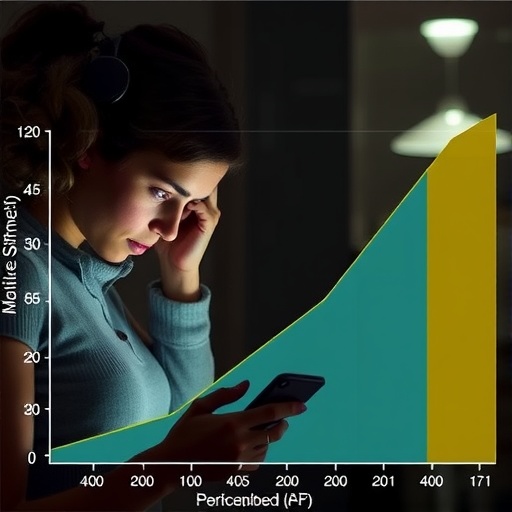In the digital age, the omnipresence of mobile phones has revolutionized how young people interact, learn, and entertain themselves. Nonetheless, this transformation is not without its psychological repercussions, especially for preadolescents and adolescents, groups whose behavioral patterns and mental frameworks are still in formative stages. A groundbreaking longitudinal study recently published in the International Journal of Mental Health and Addiction delves deeply into the nuanced interaction between gender, personality traits, and the progression of mobile phone addiction during these formative years. The study offers unprecedented insights into how intrinsic factors like the Big Five personality dimensions mediate addiction trajectories, shedding light on potential intervention pathways to curtail the escalating psychological costs associated with excessive mobile phone use.
This longitudinal research is pivotal in the context of existing literature, primarily because it transcends cross-sectional snapshots, instead tracking behavioral changes over an extended period. By doing so, it captures the dynamic evolution of mobile phone addiction in young populations, which is often obfuscated in shorter-term studies. The methodology is robust, leveraging standardized assessments of personality traits defined under the Big Five model—openness, conscientiousness, extraversion, agreeableness, and neuroticism—while simultaneously accounting for gender differences. These dual lenses provide a sophisticated analytical framework for understanding the divergence in addiction patterns between boys and girls, as well as between various personality profiles.
The study’s sample comprised preadolescents and adolescents recruited from diverse educational institutions, ensuring representativeness and minimizing socio-demographic confounds. Participants underwent periodic assessments, which included validated self-report measures of mobile phone use and addiction symptoms, alongside personality inventories tailored for developmental appropriateness. This rigorous longitudinal design enabled researchers to map trajectories of addiction symptoms over time and correlate these with baseline and evolving personality profiles. Importantly, the analyses incorporated advanced statistical modeling techniques, such as latent growth curve modeling, to isolate individual variations in addiction pathways.
.adsslot_SIY0kDgWHy{ width:728px !important; height:90px !important; }
@media (max-width:1199px) { .adsslot_SIY0kDgWHy{ width:468px !important; height:60px !important; } }
@media (max-width:767px) { .adsslot_SIY0kDgWHy{ width:320px !important; height:50px !important; } }
ADVERTISEMENT
One of the most salient findings highlighted by the researchers is the differential impact of specific personality traits on mobile phone addiction trajectories. Neuroticism—the tendency towards emotional instability, anxiety, and vulnerability to stress—emerged as a significant predictor of increasing addiction symptoms. Adolescents exhibiting higher baseline levels of neuroticism demonstrated steeper upward trajectories in problematic mobile phone use, suggesting that emotional dysregulation may drive compulsive behavior in digital contexts. This insight aligns with broader psychological theories positing that individuals with higher neuroticism may resort to technology use as a maladaptive coping mechanism for negative affective states.
Conversely, conscientiousness showed a protective effect against the escalation of mobile phone addiction symptoms. Adolescents characterized by traits such as self-discipline, organization, and goal-directed behavior were less likely to develop severe addiction trajectories. This finding has significant implications for intervention development, affirming that enhancing self-regulatory capacities could buffer youth from succumbing to problematic digital behaviors. It also underscores the importance of fostering executive functioning skills in educational and familial settings to mitigate addiction risk.
Another intriguing dimension uncovered involves gender-specific differences in addiction pathways. The study found that female participants generally exhibited accelerated growth in mobile phone addiction symptoms relative to their male counterparts. This disparity is potentially rooted in gender-related socialization processes and usage patterns; females may engage more intensively in socially mediated phone functions like messaging and social networking, which can foster addictive behaviors through reinforcement loops inherent in social validation systems. Moreover, hormonal and neurodevelopmental differences during adolescence may exacerbate susceptibility, although these biological underpinnings warrant further exploration.
In contrast, males did not show as steep an increase in addiction symptoms over time but demonstrated variability influenced heavily by personality type. For instance, high extraversion—characterized by sociability and impulsivity—was a notable factor for some males developing elevated addiction trajectories. This pattern suggests that for boys, the stimulating, interactive affordances of mobile phones may cater to extraverted tendencies, reinforcing engagement and potentially tipping into addictive usage. Thus, personality interacts complexly with gender to produce distinct pathways towards addiction.
The comprehensive analytical approach adopted by the research allows for controlling numerous confounding variables including socioeconomic status, baseline mental health, and academic performance, enhancing the validity of observed personality and gender effects. Additionally, the researchers emphasize the temporal sequencing of data collection as crucial in disentangling cause-and-effect relationships, moving beyond correlations toward a more causal understanding of how personality predispositions dynamically influence behavioral outcomes over time.
From a technological perspective, the findings underscore the dual-edge sword of mobile devices. While serving as indispensable tools for communication and learning, they engender psychological vulnerabilities in sensitive populations. The study’s complexity extends to recognizing that addiction is not a monolith but rather a trajectory molded by ongoing internal and external factors. This perspective challenges simplistic dichotomies of “addicted” versus “non-addicted” users, recommending a more nuanced, developmental lens in both research and clinical practices.
Crucially, the implications for public health policy and educational programming are profound. Tailored interventions that factor in personality profiles and gender-specific risks could be more effective in preempting or reversing mobile phone addiction trends. For example, resilience training focused on emotional regulation could buffer neurotic youths, while curricula enhancing conscientious habits could fortify executive control across genders. Awareness campaigns might also benefit from gender-sensitive messaging that resonates with distinct user experiences and motivations.
Furthermore, the study points toward the potential utility of digital phenotyping techniques, where real-time data from mobile devices could be harnessed to identify at-risk individuals based on usage patterns aligned with personality traits. Implementing ethical frameworks for such data collection could open avenues for personalized feedback mechanisms, nudging users toward healthier engagement. Integrating these innovations with developmental psychology insights marks a frontier for combating digital addiction.
Despite its comprehensive nature, the authors acknowledge limitations inherent in self-reported data, including potential biases and inaccuracies. Future research paths call for multimodal data collection incorporating behavioral analytics, physiological monitoring, and informant reports to triangulate findings. Longitudinal research extending into late adolescence and early adulthood would also elucidate whether observed trajectories persist, stabilize, or evolve with maturational changes and shifting social contexts.
In sum, this seminal study provides a nuanced, multidimensional portrayal of how gender and Big Five personality factors orchestrate the unfolding of mobile phone addiction during crucial developmental windows. It bridges psychological theory with practical concerns in the digital era, offering a roadmap for research, intervention, and policy to align technological advancement with mental health preservation. As mobile technology continues its inextricable integration into young lives, such evidence-based insights are indispensable for safeguarding the well-being of future generations.
By illuminating the interplay between inherent personal traits and addictive behavioral dynamics, the research also invites reflection on broader societal responsibilities. It compels stakeholders—educators, parents, clinicians, and tech designers—to consider how environments can be structured to promote balanced technology use while respecting individual differences. The challenge remains to harness the benefits of mobile devices without yielding to their potentially deleterious psychological effects, a mission this study significantly advances.
Subject of Research: The study investigates the role of gender and Big Five personality traits in the longitudinal trajectory of mobile phone addiction among preadolescents and adolescents.
Article Title: The Role of Gender and Big Five Personality in the Trajectory of Mobile Phone Addiction: A Longitudinal Study of Preadolescents and Adolescents.
Article References:
Fu, L., Xie, X. & Xiang, Y. The Role of Gender and Big Five Personality in the Trajectory of Mobile Phone Addiction: A Longitudinal Study of Preadolescents and Adolescents. Int J Ment Health Addiction (2025). https://doi.org/10.1007/s11469-025-01541-y
Image Credits: AI Generated
Tags: behavioral changes in youth technology useBig Five personality traits and addictiongender and technology interactiongender differences in mobile phone addictionintervention strategies for phone addictionlongitudinal study on technology usemental health and technology usepersonality dimensions and technology engagementpreadolescents and adolescents behavior patternspsychological costs of mobile phone dependencypsychological impacts of mobile phone addictionyouth addiction to smartphones





